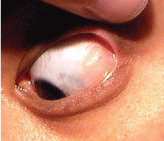 History
History
A 26-year-old Hispanic female presented for a semi-annual eye exam with a complaint of foreign body sensation and irritation of the superior-temporal region in her left eye. The patient has been seen every six months since June 1998, when she suffered a traumatic retinal detachment in her left eye that was subsequently repaired.
She demonstrated no other ocular symptoms, and her general medical status was unremarkable. Her ocular and medical histories were also non-contributory, and she denied having any drug allergies.
A 26-year-old female presented with foreign body sensation and irritation O.S.
Diagnostic Data

Her best-corrected visual acuity was 20/20 O.D. and 20/40 O.S. An external examination revealed an elevated, tender region underneath the left upper eyelid. When the lid was lifted, a deep elevation could be seen in the superior temporal conjunctiva, as illustrated in the photograph. All other external testing was normal O.U.
Biomicroscopy uncovered grade 3 injection of the superior-temporal conjunctiva, no cells or flare, and normal iris and lens structures. Her intraocular pressure measured 13mm Hg O.U.
The dilated fundus examination of the patients right eye was normal. However, binocular indirect biomicroscopy of the left eye demonstrated tight laser scars from an old barrier laser treatment, as well as a peripheral retinal indentation where a scleral buckle was placed. There was no evidence of any new areas of retinal detachment or holes O.U.
Your Diagnosis
How would you approach this case? Does this case require any additional tests? What is your diagnosis? How would you manage this patient? Whats the likely prognosis?
Thanks to Marc Myers, O.D., of
The Diagnosis
The diagnosis in this case is a scleral buckle displacement. Scleral buckle displacement is a rare, late complication that follows repair of a retinal detachment. The most common sign of displacement is an elevation deep within the conjunctiva where the scleral band protrudes outward. Associated complications involving the internal structures of the eye are rare, particularly in patients with long-standing buckles.1,2
Further management included monitoring the position of the buckle and looking for development of an open wound involving the superficial tunics of the eye over the area of the displacement. In cases in which open wounds occur, topical antibiotics are used to prevent infection. Surgical intervention may include a pericardium patch graft, or the buckle may have to be removed.1,2
The patient was referred to a retinologist to assess the integrity of the scleral buckle, as well as the health of the retina in the left eye. The retinologist determined that the elevation deep within the conjunctiva was secondary to the displaced scleral buckle. The displaced buckle was responsible for the reported foreign body sensation.
There was no evidence of an open superficial wound at the time of either our consultation or the retinologists consultation, and the peripheral retina showed no signs of new holes or detachment.
2. Weissgold, DJ, Millay RH, Bochow TA. Rescue of exposed scleral buckles with cadaveric pericardial patch grafts. Ophthalmology 2001 Apr;108(4):753-8.











